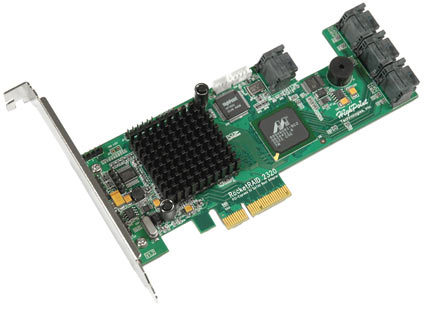PCI Express Battles PCI-X
Is PCI Express Really Any Better Than PCI-X?
HighPoint's RocketRAID 2320 is the second SATA II RAID controller card with a PCIe interface.
The PCI Express (PCIe) interface has been around for about a year and a half now, but so far it has only been able to establish itself as a graphics interface. Desktop motherboards with PCI Express support additional expansion slots, but today these are being used just as infrequently as their higher bandwidth versions on server and workstation motherboards.
While in theory PCI Express x16 can offer clearly more performance than PCI-X 533 - 8 GB/s compared to 4.26 GB/s - it is important to underscore that PCIe was not developed to replace PCI-X, but rather some of the older add-in card interfaces. It was aimed at replacing AGP graphics for marketing reasons, and enabling the dual graphics pathway. The aged parallel 32 Bit PCI bus also required replacement; , it can only be called lame today, as its total bandwidth is relatively low and shared among all PCI devices. Modern technology applications - such as Gigabit Ethernet, high definition content-related hardware and storage adapters - require higher bandwidth that is constantly available.
This brings us to what PCI Express as a system expansion interface is really all about: not necessarily being faster than PCI-X, but rather being simpler and offering bandwidth to each device separately. Hence there are more and more professional server/workstation class chipsets that put emphasis on PCI Express, because having bandwidth dedicated to each device is appealing.
One of the most obvious applications here are mass storage and network adapters, since these will be readily impacted by bottlenecks. Obviously, setting up a 10 Gbit Ethernet environment for testing requires more time than using mass storage devices, which explains our decision to use RAID for testing.
We picked two of the latest HighPoint Serial ATA II RAID RocketRAID controllers, the 2220 and 2320, since these two cards are based on the same technology with only the interface differing. The 2220 is the PCI-X model while 2320 is based on x4 PCI Express; the latter seems to be the faster model.
Get Tom's Hardware's best news and in-depth reviews, straight to your inbox.
Current page: Is PCI Express Really Any Better Than PCI-X?
Next Page PCI-X Explained
Patrick Schmid was the editor-in-chief for Tom's Hardware from 2005 to 2006. He wrote numerous articles on a wide range of hardware topics, including storage, CPUs, and system builds.
-
herb2021 Buyers need to be very aware of limited compatiblility with many of today's MB. Will not work in many machines. Highpoint Tech support is one of the worst I have worked with. No indication of any technical ability in those I have worked with.Reply
